Mark Sisson's Blog, page 352
January 10, 2013
13 Ways to Spend Less Time Online and Reclaim Your Real Life
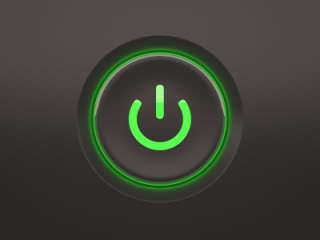 The average American spends eight hours a month on Facebook, up from nearly six hours per month back in August 2010. As of 2009, the average young adult was spending virtually every waking hour with online access, either through their phones or their computers, and they were actively using them for two hours a day. Restaurants and bars and coffee shops across the world are littered with broken-neck zombies gazing into their smartphones. I’ve seen entire families out to dinner, each member’s attention fixated on an iPhone as they spoon food into mouth, pausing only to breathe and guzzle cola. I’ve seen young guys out at bars who, instead of checking out the women at the next table over or jabbering at each other with youthful exuberance, feel the need to tell everyone on their Facebook lists just how much fun they claim to be having. I’ve even caught myself lingering at the computer after work, doing nothing of import even as a gorgeous spring day ticks away into the ether of time right outside the window. Why? Just what the heck is our collective problem?
The average American spends eight hours a month on Facebook, up from nearly six hours per month back in August 2010. As of 2009, the average young adult was spending virtually every waking hour with online access, either through their phones or their computers, and they were actively using them for two hours a day. Restaurants and bars and coffee shops across the world are littered with broken-neck zombies gazing into their smartphones. I’ve seen entire families out to dinner, each member’s attention fixated on an iPhone as they spoon food into mouth, pausing only to breathe and guzzle cola. I’ve seen young guys out at bars who, instead of checking out the women at the next table over or jabbering at each other with youthful exuberance, feel the need to tell everyone on their Facebook lists just how much fun they claim to be having. I’ve even caught myself lingering at the computer after work, doing nothing of import even as a gorgeous spring day ticks away into the ether of time right outside the window. Why? Just what the heck is our collective problem?
The obvious solution is to not spend so much unnecessary time online, but we pretty much all know that. Just like we know we should lose that weight, exercise more regularly, read that book, watch that Blu-ray that Netflix sent us two months ago. But is that really a solution, or is it just stating the end goal? I think it’s the end goal, not the answer. The trick lies in figuring out how to reach that goal. That’s the key, and that’s what we should be focusing on: how to get ourselves to spend less time online and more time out in the real world. Stuff like “just don’t go online!” or “don’t check your email” isn’t really useful advice, so we won’t even go there. I also won’t tell you what to do with your free, real time, since you know what to do. I’m just going to help you figure out how to get more of it.
So, how to do it?
Work More Efficiently and Waste Less Time on Internet Frivolity
…so that you have more free time to do what you really want.
I like frivolity. The tendency to goof off and act silly and waste time is part of what makes us human, but if that tendency is preventing you from getting important things done, you’re only hurting your ability to really enjoy yourself. How many people have taken ten hours to do a task that should have taken two, all because they were clicking back and forth between online forums, Facebook, Twitter, and funny cat pics when they should have been working? Sure, you “enjoyed” yourself, but wouldn’t you have rather finished the task in two hours and had eight hours all to yourself? I find that when I waste time doing “fun” stuff when I could be more productive, I don’t actually enjoy the fun at all simply because lurking in the back of my mind is the knowledge that I should be doing my work. I’ll take the eight, totally unencumbered hours every single time.
What are some ways to improve our efficiency and stop wasting time for those of us who have to work online?
Try RescueTime
RescueTime is a time management and analytics application for “knowledge workers.” In other words, if you depend on a computer for your employment, the app will let you know where you’re spending your time on that computer. It will break down how much active time you spend on various websites and applications. We oftentimes don’t know how wasteful we’re being until we see it laid out in front of us in excruciating detail, so this can be very useful for identifying a problem. It also allows you to go into “Focus mode,” which prevents you from visiting the most disruptive (as deemed by the application’s analysis of your habits) websites. RescueTime is available for Mac and PC.
Use Self Control
No, I didn’t just break my promise not to give redundant, tautological advice. Self Control is an application for MacOS that allows you to put certain websites on a “blacklist.” Once you activate the timer, you will be unable to visit the websites on your blacklist for the time you’ve allotted. Even if you restart your computer or try to delete the program, you’ll remain barred from the offending websites. For the person with absolutely zero willpower (which is a surprising number of us), Self Control will prove invaluable. Obviously, you don’t use Self Control to stay offline. You use Self Control to get your work done faster so that you can log off quicker and get back to the real world. For PC users, Freedom is a similar app.
Establish Scheduled Breaks
Few can work straight through for eight hours without a break, and I don’t think you should even try to attempt such a feat. Instead, you should take breaks. Real breaks, though – scheduled ones. Don’t just flit around Facebook in the midst of your work whenever it strikes your fancy, because it’ll strike your fancy more often than not and you’ll end up wasting too much time. I find that setting aside time slots for regular breaks works way better than winging it. Try taking a ten minute break for every 50 minutes of solid work. You’re gonna take breaks regardless; you might as well try to make them work for, and not against you.
Take Your Breaks Away from the Computer
While you could use those ten minutes to feverishly consume the latest tweets, I’d say your time would be better spent away from the computer. Get up and do a quick ten minute workout. Bang out some pushups, pullups, and air squats. See how long you can hold a plank. Take a short walk outside. Meditate. Or, if it’s a real busy day, step away from the keyboard and give real, ponderous thought to the day’s tasks. You might have a revelation or breakthrough, thereby giving you a boost in efficiency. And even if you don’t, you won’t have wasted your break online.
Use the Internet as an Enhancement of Real Life
Above all else, the Internet is an incredibly powerful tool for connecting people and collating easily-accessible information. If we use the available tools to connect with people, pursue and research real-life interests, and learn about the world – and then apply the newfound knowledge – the Internet can be an enabler of real lives. It’s only when going online replaces real world interactions and experiences that things get all screwy.
What are some ways to enhance our real lives with the Internet?
Make Concrete Plans with Friends
Instead of idly chatting to your buddy whom you’ve not seen in months “Oh, we should totally grab dinner sometime,” say “Let’s grab dinner next Wednesday.” See the difference? In the first example, you’re just saying stuff to make yourself feel better for not having seen your friend without actually having to see the person – you’re not planning anything. In the second example, you’re actually making plans to see the person. You have to commit.
Use Online Apps to Create Events
Whether it’s Facebook, Google Calendar, Evite (are the kids still using Evite these days?), or any other calendar/invitation app, tool, or website, create events and then invite your friends to them. Take the initiative. Besides, chances are they’re spending all their time on Facebook, too, so they’re going to see your invite.
Use Meetup – Don’t Just Join It
Plenty of people join Meetup groups that sound interesting. “Oooh, transcendental meditation!” or “Hey, I like car camping! Why not?” They join, but they never actually attend a meet-up. Seriously: Googling “inactive meetup members” gets you tons of hits from blogs and message boards complaining about all the inactive members in various Meetup groups. This is a huge mistake, because more than the “thing” the group is about, you’re actually going to meet interesting people that happen to enjoy the same things you enjoy. Meetup can be a powerful tool, as long as you actually use it.
Just Don’t Use the Internet
At some point, you’re going to have to not use the Internet in order to enjoy real life. You don’t have to give it up entirely of course, but you will have to have some electronic-free time.
Here are a few ways to go about this.
Every Day, Set Aside Two Hours of Non-Internet Time
You can use your phone to listen to stored music as you go about your day. You can use your computer to write in your journal. You can use your Wacom tablet to draw. But that’s about it. Not counting sleep, grooming, eating, bathrooming, getting ready for bed, and commuting to and from work, set aside two hours out of every day to not use the Internet. Use this time to cook and enjoy a delicious meal, hang out with friends and loved ones, go for a walk, lift some heavy things, read a good book, write a letter, pet your dog/cat, or look at clouds. Just don’t whip out the smartphone or flip open the laptop for those two hours (which can be broken up into two single hour sessions, if you like).
Go Camping
I find that whenever I go camping, I forget about the emails, the backed up posts in the queue, the blog post ideas, whatever projects I’m working on, and my smartphone. Oh, sure, maybe for the first couple of hours I’ll pace around the campground trying to find the spot that offers phone reception, but that soon falls by the wayside. The phone gets put away – or maybe used to play some tunes at night – and I lose myself in the great big wild. And then I end up finding myself, if you know what I mean.
Go a Whole Day Without the Internet
Take a day off from it all. Use your phone only as a phone. Let your contacts know what’s going down, of course, particularly if your livelihood depends on it, and set up an “out of office” email alert for those who write to you. This is going to be hard, it’s going to be scary, and it’s going to feel impossible at first. That’s okay – just stick with it. It’s only a day. When the day is up, review. Was it hard? Was it miserable? Did you pine for Facebook? Then you probably really, really needed this day off (and many more). And now you know it’s possible. After all, you’re still alive.
Leave the Phone at Home From Time to Time
We like to think we “need” our phone for emergencies, but how often do those really come up? Flat tires, sure. Getting locked out, okay. What else? Yeah, not much, right? Next time you’re heading out to do some shopping or run errands, leave the phone at home. You don’t really need it.
Turn the Phone Off When It’s In Your Pocket or Purse
When you do have your phone on you, keep it turned off when you’re on the move. Once you arrive, turn the phone on so you can receive and make calls, but don’t be that person bumping into people on the street, walking into fire hydrants, getting run over by street sweepers, or walking right off of cliffs (this isn’t a Looney Tunes cartoon and you won’t have the time to look down, realize your predicament, and run back to safety), all because you had your nose in an iPhone.
If you’re one of the rare birds that honestly cannot live without being connected, have at it. If you truly and honestly love and cherish every single minute you spend online and would rather give up sex than Facebook, then do it. But I suspect that most of you, even the ones who profess their undying love to the Internet, secretly wish you could spend more time offline. Ultimately, it’s going to come down to deciding not to spend so much time in front of the screen(s), and these tips, tricks, and techniques should help get you closer to that decision.
Of course, all the aforementioned advice should be utterly disregarded when it comes to your perusal and consumption of Mark’s Daily Apple.
Let me know what you think of my ideas, guys, then be sure to leave a comment or two with your own tips. Thanks for reading!
Order The Primal Connection by Jan. 10 and Get Free Gifts!
 The Primal Connection, the long-awaited sequel to The Primal Blueprint, is finally here! As friends and colleagues within the ancestral movement have so generously described, The Primal Connection offers the first really new dimension in the paleo/Primal space in years.
The Primal Connection, the long-awaited sequel to The Primal Blueprint, is finally here! As friends and colleagues within the ancestral movement have so generously described, The Primal Connection offers the first really new dimension in the paleo/Primal space in years.
Like The Primal Blueprint, The Primal Connection is both a culmination and expansion of principles I’ve first introduced here on MDA. It picks up where The Primal Blueprint left off, by extending the primal theme beyond the diet and exercise basics. In it I present a comprehensive plan to overcome the flawed mentality and hectic pace of high-tech, modern life and reprogram your genes to become joyful, care-free, and at peace with the present. The central premise of The Primal Connection is that we can use the model of our ancestors to create not just a healthier physical existence but also a more balanced and fulfilling life. My hope is that upon reading it you’ll emerge with a renewed appreciation for the simple pleasures of life and our most precious gifts of time, health, and love.
Just as I like to do for all of my book releases, I have something special put together for devoted Mark’s Daily Apple readers. I’m offering you some fantastic free gifts when you buy one or more copies by Thursday, Jan. 10, 11:59 pm PST. Read all the details here.
Order Your Copy of The Primal Connection and Claim Your Free Gifts Today !

January 9, 2013
10 Habits of Highly Successful Hunter-Gatherers
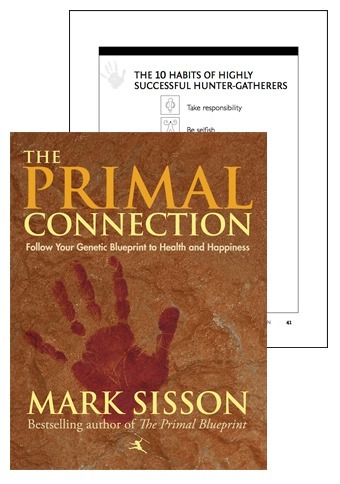 What would it take to be a highly successful hunter-gatherer? Brawn? Speed? And good aim? Stamina? Carving skills? A sharp eye or memory? Of course. But what about those less obvious attributes like creativity, empathy, intuition, even-temper, mettle, compassion, coolheadedness? After all, all the strength in the world won’t match a good weapon in many situations. A lone wolf will always be more vulnerable on the savanna than his connected counterparts. An easygoing perspective can make living with others easier. Equanimity keeps emotional responses in check and critical focus in the present. Grit can mean the difference between life and death. If the hard knocks of evolutionary history cultivated these kinds of pivotal traits in our ancestors, how do we reconnect with – and benefit from – them today? What better (and even fun) self-development project can there be, after all, than fostering the habits of highly successful hunter-gatherers?
What would it take to be a highly successful hunter-gatherer? Brawn? Speed? And good aim? Stamina? Carving skills? A sharp eye or memory? Of course. But what about those less obvious attributes like creativity, empathy, intuition, even-temper, mettle, compassion, coolheadedness? After all, all the strength in the world won’t match a good weapon in many situations. A lone wolf will always be more vulnerable on the savanna than his connected counterparts. An easygoing perspective can make living with others easier. Equanimity keeps emotional responses in check and critical focus in the present. Grit can mean the difference between life and death. If the hard knocks of evolutionary history cultivated these kinds of pivotal traits in our ancestors, how do we reconnect with – and benefit from – them today? What better (and even fun) self-development project can there be, after all, than fostering the habits of highly successful hunter-gatherers?
In addition to reconnecting with our natural environments, rhythms, and biomechanics, it’s impossible to discount the relevance of these more cognitive elements. Sure, it’s the stuff that can’t be nailed down. When it comes to our ancestors’ neurological trajectories, we have the likes of skull proportions and tool complexity to compare. Beyond that, the specifics get dicey. Grok and his kin left no diaries or personal blogs. The more intimate details of their lives will never be known, as much as we might like to imagine their stories. Nonetheless, we can extrapolate from the conditions in which we theorize our ancestors lived and then target what skills and perspectives those environments would’ve required or at least favored for survival. (The observations of traditional societies living today add to this picture in their own partial way, but that’s fodder for another discussion.)
The idea here isn’t an academic model. Yet, it’s not tongue-in-cheek either. What we’re after, of course, is a practical point of reference for the everyday person who wants to enjoy life for all the fulfillment, happiness, and peace that he or she can find in it. There’s something to speculating about Grok’s angle on life and what we can safely assume was a striking contrast to the modern mindset that too often breeds stress, disengagement, and impatience. What’s to be gained from the perspective of Grok, our resident highly successful hunter-gatherer? Consider his evolutionary context a touchstone we can use in life to gauge our own sense of balance. It’s a reminder to question cultural scripts in pursuit of something more timeless and fundamentally sensical. As a touchstone, it can help us imagine – design for ourselves really – an ancestrally-informed point of homeostasis we endeavor to thrive within each day.
This is the Primal purpose of the very first chapter of The Primal Connection. For those of you waiting for your copy to arrive (and for those who haven’t snagged a copy yet), consider it a brief taste for all that’s covered in chapter one.
Habit #3: Build a Tribe
Our ancestors depended upon a tight knit social circle. Their survival hinged upon it in fact. The band community of 25-50 people was forged within a sense of mutuality – action for the good of the group. It was more than simple transaction, larger than familial connection (not everyone was related). You became kin by being kin and sharing in the menial work, the ongoing stories, and the meaningful celebrations of the band.
In this day and age, we live in proximity to numbers that would’ve stunned our ancestors. We count our social media “friends” into the hundreds, but we often miss a sense of close, continual connection. Exposure doesn’t fill our social wells. Neither do status updates.
These days we can even go through our adult lives with few, if any, intimate relationships – the kind of connections that feel like kin – our own tribe. You’ve seen each other through transitions, successes, and disappointments. You have history and your own stories. The fact is, we haven’t outgrown or out-evolved the need for kin, however. We live with the same genes that benefited from social connection and the same biochemistry that rewards it. With frequent relocations and busy lives, connecting gets complicated. Too many of us end up socially adrift.
If you find yourself at this point in your life without a core group, build one. Don’t make the excuse that you just missed the boat. It’s just too important. You’ll be glad you didn’t later. Feed this “highly successful” habit by first deepening the relationships you already have. When you begin seeing your partner, family members, kids, and closer friends as your tribe, you gain a whole new level of appreciation for the role they play in your life. Reconnect with old friends, and test the waters to see if there’s potential there to become close again. Get out into the world, meet people, and make an invitation. Invite a coworker for lunch. Join a book group or basketball league. Start a volunteer team at your house of worship or place of work. Create a Meetup group. Host an open house for the neighbors. Over time, cultivate the relationships that seem most genuine and promising. Cultivate that mutuality in small but significant ways. Bring your best to the friendship and expect the same in return.
Habit #4: Be Present
We can all do a self-inventory now of the attention we give our phones or other technological devices. We can confess to ourselves how much we let residual work infiltrate our personal lives. Don’t forget what I think is one of our biggest trip-ups in modern living: the penchant for mental chatter. Truth be told, how much time do we spend caught up in replaying a conversation from the previous evening, imagining multiple stressful scenarios that might take place when we confront a certain person about x, y, and z, worrying about what other people think of our outfit or hair today? Let’s face it, our modern disconnect is rampant distraction.
Can you imagine if Grok walked across the savanna perpetually lost in thought about his latest wardrobe experiment? (As if he ever saw his reflection anyway…) He wouldn’t last long enough for it to matter. For our ancestors, life was an exercise in continual hypervigilance. Not every second, but close. It wasn’t just the risk of becoming another creature’s dinner either. Attentiveness also meant watching for weather, catching migratory patterns, and deciphering water sources – just to name a few examples.
The Primal Connection is to be found in giving the moment your full attention. It’s about minding the difference between thoughtful deliberation or reflection and so-called monkey brain. It’s about throwing off the strangling self-absorption we trap ourselves in every day standing in line with our phones or with our self-chatter. See the people, places, and possibilities in front of you. Feed this “highly successful” habit by observing your loved ones – all the changes and uniqueness that’s right there to be appreciated. Go on a walk with the goal of finding at least a dozen things you’ve never noticed. Use mindfulness check-ins to remind yourself to come down from the mental busyness and come back to center throughout the day.
Habit #8: Get Over It
As Michael E. McCullough, author of Beyond Revenge: The Evolution of the Forgiveness Instinct, explains, the ability to forgive is as much a result of natural selection as the impulse for revenge. Forgiveness, he suggests, likely evolved as a means of social cooperation. For our ancestors, life was about conservation – of energy, of resources, of good will. In a cost-benefit analysis, nursing an unrelenting grudge would’ve been a major liability. If you couldn’t get along with the group, eventually you likely wouldn’t have been welcome anymore. Be upset, sure. But once it starts eroding the group dynamic, you’d better find yourself another band. The risk wasn’t worth the emotional indulgence.
Although stewing ad nauseum today usually doesn’t present the critical threat of banishment, we still wallow to our own detriment. How much of ourselves do we tie up in the binds of past offenses or travails? How long will we allow ourselves to be stuck, and what are we missing out on in that time? At what point is it not even about the original sin anymore but our own circuitous, self-sustaining grief? The fact is, each day we let a past hurt, disappointment, or mistake determine our wellbeing, is a day we miss living full measure of ourselves and our potential for happiness.
A highly successful Grok type can do the (albeit modern) cost-benefit analysis and learn to let it go. What are the annoyances and resentments that we can simply release for more peace of mind? Feed the “highly successful habit” by cleaning the slate of past negativity. Use some kind of ritual if you feel it would be helpful to create a more genuine emotional closure. Keep an uncluttered emotional canvas by avoiding the minor, inconsequential conflicts that can build up for no good reason at home, among friends and family, or in the office. Learn to stop yourself when you go down that road of downer self-chatter. Cut the impending hormonal cascade in its tracks, and redirect your thoughts.
These are among the habits I call our inner dialogue – the assumptions, patterns, and narratives we can create or accept for ourselves. That dialogue has the power to limit or expand our lives. It will influence our potential to connect with the world and those around us. It will ultimately determine how successfully we live as modern hunter-gatherers but most importantly whether or not we will live the full measure of our Primal selves in this lifetime. Let me know your thoughts on living as a successful hunter-gatherer – and what you’ve gained from the other seven habits if you’re already delving into the book.
Thanks for reading today, everyone. If you haven’t picked up your copy of The Primal Connection, order yours today to learn the other seven habits of highly successful hunter-gatherers and take advantage of the release offer while it lasts!
Order The Primal Connection by Jan. 10 and Get Free Gifts!
 The Primal Connection, the long-awaited sequel to The Primal Blueprint, is finally here! As friends and colleagues within the ancestral movement have so generously described, The Primal Connection offers the first really new dimension in the paleo/Primal space in years.
The Primal Connection, the long-awaited sequel to The Primal Blueprint, is finally here! As friends and colleagues within the ancestral movement have so generously described, The Primal Connection offers the first really new dimension in the paleo/Primal space in years.
Like The Primal Blueprint, The Primal Connection is both a culmination and expansion of principles I’ve first introduced here on MDA. It picks up where The Primal Blueprint left off, by extending the primal theme beyond the diet and exercise basics. In it I present a comprehensive plan to overcome the flawed mentality and hectic pace of high-tech, modern life and reprogram your genes to become joyful, care-free, and at peace with the present. The central premise of The Primal Connection is that we can use the model of our ancestors to create not just a healthier physical existence but also a more balanced and fulfilling life. My hope is that upon reading it you’ll emerge with a renewed appreciation for the simple pleasures of life and our most precious gifts of time, health, and love.
Just as I like to do for all of my book releases, I have something special put together for devoted Mark’s Daily Apple readers. I’m offering you some fantastic free gifts when you buy one or more copies by Thursday, Jan. 10, 11:59 pm PST. Read all the details here.
Order Your Copy of The Primal Connection and Claim Your Free Gifts Today!

January 8, 2013
Introducing The Primal Connection
 I’m pleased to announce the release of The Primal Connection. Three years in the making, this new book explores the assorted genetic disconnects inherent in hectic modern life and how to correct them. As friends and colleagues within the ancestral community have so generously described, The Primal Connection offers a fresh perspective and an extension of the evolutionary health theme outside the basics of diet and exercise for the first time.
I’m pleased to announce the release of The Primal Connection. Three years in the making, this new book explores the assorted genetic disconnects inherent in hectic modern life and how to correct them. As friends and colleagues within the ancestral community have so generously described, The Primal Connection offers a fresh perspective and an extension of the evolutionary health theme outside the basics of diet and exercise for the first time.
Like The Primal Blueprint, The Primal Connection is both a culmination and expansion of principles I’ve first introduced here on MDA. It picks up where The Primal Blueprint left off. In it I describe a comprehensive plan to overcome the flawed mentality and hectic pace of high-tech, modern life and reprogram your genes to become joyful, care-free, and at peace with the present. Inherent to The Primal Connection is the concept that we can use the model of our ancestors to create not just a healthier physical existence but also a more balanced and fulfilling life. My hope is that upon reading it you’ll emerge with a renewed appreciation for the simple pleasures of life, and our most precious gifts of time, health, and love.
Just as I like to do for all of my book releases, I have something special put together for devoted Mark’s Daily Apple readers. Below you’ll find a limited-time (just two days!) bonus offer. But before we get to that, here’s a little more about the book…
If you are diligently adhering to the evolutionary model of what to put in your mouth and how to exercise, you have sufficient momentum to create a deeper and more fulfilling connection with your genetic expectations for health, happiness, and wellbeing. The Primal Connection is about not resting on your laurels, but rather directing existing Primal momentum that you have into intangible, esoteric topics such as your thoughts and interpersonal relationships. Yep, our evolutionary history also shaped our “best practices” for thinking, socializing, touching, feeling, and experiencing the world. By paying attention to and learning from our ancestor’s social and mental “environments,” we can apply those lessons to the modern day and become happier, healthier, more productive, and more fulfilled as a result.
During the writing journey, it was wonderful to realize how many academics and scientists are devoting their life’s work to the topics that we banter about on Mark’s Daily Apple and in the larger community. For example, Stuart Brown, the world’s leading scholar on play. Or microbiology and immunology expert Mary Ruebush, who explains how being in contact with dirt (gardening, playing with kids, doing those crazy-popular mud runs) and relaxing our hygiene standards in general (time to ditch the antibacterial wipes!) can improve mood and immune function. Or Michael McCullough, who talks about the evolutionary underpinnings of our instinct, and need, to forgive and move on.
I cite other experts on silence (yes, three of them actually!), attention restoration through nature experiences, sleep and circadian rhythm, vitamin D and sun exposure, neuro-plasticity (keeping the brain sharp and nimble. Hint: exercise and spending time in nature help!) – all referencing the evolutionary example to describe what makes us operate optimally today. While my editors and I tried to make this book a fun and breezy read, it is steeped in the science of what I call “feelgood hormones”. Our genetically optimal behaviors stimulate the release of mood and performance-elevating hormones into the bloodstream, giving us the feedback on a cellular level that drives us to repeat these behaviors, and avoid behaviors that lack the feelgood component. For example, rushing off to a crowded mall on the heels of a stressful workday to finish your holiday shopping will leave you devoid of any feelgood component and awash in catabolic stress hormones. Is this what the holidays should be about – a cortisol bath? We know better on occasions like these (me, I prefer holiday shopping on Amazon Prime in the comfort of my office!), but sometimes we lack the roadmap, the discipline, or the motivation to act in our best interests. On the topic of feelgood hormones, it should also be noted that since we are no longer under the influence of life or death selection pressure, we must apply high level reasoning to our genetic instincts so that we act in our best long-term interests. Tiger Woods’s genetically-driven misbehavior that cost him dearly is a poignant example of how the realities and conventions of modern life are at odds with our still primitive hard-wiring, and how perilous it is to ignore this truth.
The connections in the book are organized into six categories as follows:
Inner Dialogue: Reject self-doubt and gain mastery over your thoughts and actions by following the 10 Habits of Highly Successful Hunter-Gatherers.
Body: Rediscover the pleasure of touch. Rethink footwear to cure foot and back pain; learn correct posture and biomechanics, maybe for the first time ever!
Nature: Relieve stress at the biochemical level simply by immersing yourself in pleasant natural surroundings – anywhere, even if you are city-bound.
Daily Rhythm: Prioritize healthful sleep habits, wholesome diversions, solitary downtime, and limit technology to remain focused, creative, and productive.
Social: Withstand the pull of instant gratifications and narrow your social circle to honor real-life friends over Facebook. Build a supportive and nurturing tribe.
Play: Rediscover your innate cravings for daily doses of spontaneous, physical fun! Finally understand the true meanings of pleasure and leisure.
The Primal Connection allows you to have it all; you’ll honor your ancient genetic recipe for health while still enjoying the comfort and convenience of modern life.
While I talked about Primal enthusiasts building momentum from having the basics wired, this book is also ideal for a general audience person who may not have any exposure to ancestral diet and exercise principles, and is simply interested in navigating the stresses and disconnects of hectic modern life. In the early pages, I emphasize how helpful it is to start this journey after ditching grains and avoiding chronic exercise, but this book is definitely for everyone. And for the masses of potential readers who aren’t quite devoted fitness enthusiasts, I believe The Primal Connection could be the best catalyst to date to help take the Ancestral Health Movement mainstream. I urge you to do your part to transform lives by getting this baby on the New York Times bestseller list right away, for this is an event that creates tremendous leverage and additional mainstream interest in the book, and in the movement as a whole. I need your help to do that, so I’m offering some fantastic free gifts for this urgent promotion that expires on Thursday, Jan. 10, 11:59 pm PST.
The Primal Connection Bonus Giveaway
Here’s how it works:
Order one or more copies of The Primal Connection from any retail location (online or brick and mortar) in any format (physical or digital) between now and January 10, 11:59 PST, and you’ll receive one or more bonus items as a token of my appreciation. It’s as easy as 1-2-3:
Pick one of the two bonus package below
Place your order
Send me a copy of your receipt through one of the special online forms
See the instructions and fine print below for further details.
BONUS PACKAGE #1: Order 1 Copy and You Get…
Exclusive access to my PaleoFx Seminar Presentation: In this 1-hour video recorded in Austin, Texas in March of last year at the PaleoFX symposium, I discuss how there are no right or wrong decisions in your Primal journey, only choices. I explore how to customize the Primal lifestyle to address your own unique health circumstances using self-experimentation methods. Also included is a lively Q&A session with the audience. This video isn’t available anywhere else. Order one copy of The Primal Connection and I’ll send you a password to a special page where you can stream and watch the video online.
Here’s a highlight reel to give you taste of what the presentation is all about:
BONUS PACKAGE #1 Instructions:
Buy 1 or 2 copies from Amazon, Barnes and Noble or any other book retailer.
Fill out this form to get your bonuses.
This offer is unlimited.
BONUS PACKAGE #2: Order 3 or More Copies and You Get…
Exclusive access to the PaleoFx Seminar Presentation highlighted above PLUS…
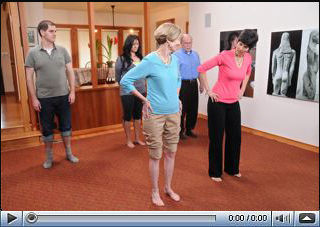
Access to a video presentation from posture specialist Esther Gokhale:
In a 15-minute preview of the Primal Posture Solution DVD you’ll receive extensive instruction on stretchsitting and the inner corset (two major components of Esther’s program), as well as a rich introduction into the theory behind the Gokhale method.
I’ve been a long-time supporter of Esther and the work she does helping people correct years of poor standing, sitting and walking techniques. So much so that I asked her to come to the inaugural PrimalCon some years back, and I discuss her methodology in The Primal Connection. Anyone that’s been to PrimalCon and has sat through one of Esther’s or her daughters’ presentations knows how valuable this information is. Whether you have back pain or not, the Gokhale method is an invaluable resource that teaches us how to re-establish our body’s structural integrity and live a pain-free life. Order 3 or more copies of The Primal Connection and I’ll send you a password to a special page where you can stream and watch the video online.

A $10 Gift Certificate to PrimalBlueprint.com:
Spend it like cash and order whatever you want, perhaps the prequel to The Primal Connection, The Primal Blueprint? Or maybe one of the nifty new apparel items we have in stock? (This gift certificate expires on 02/28/13.)
 A $10 Gift Certificate to Tendergrass Farms:
A $10 Gift Certificate to Tendergrass Farms:
The Tendergrass Farms online marketplace serves as a way for us to support a number of small family farms that might not otherwise be able to find the customers they need to survive.
With this $10 gift certificate you can take your pick from a variety of grass-fed, pastured and organic meats such as flat iron steak, whole organic turkeys, grass-fed ground beef, and help sustain local grass-fed family farmers and their superior quality food in the process. (This gift certificate expires on 02/19/13.)
BONUS PACKAGE #2 Instructions:
Buy 3 or more copies from Amazon, Barnes and Noble or any other book retailer.
Fill out this form to get your bonuses.
This offer is limited to the first 2,000 form submissions.
Many thanks to everyone that purchases one ore more copies of The Primal Connection in the next couple days. I appreciate your support and hope that this new book will touch your lives just as Mark’s Daily Apple and The Primal Blueprint may have in the past. Grok on!
Fine Print:
This special bonus offer ends at 11:59 pm, Jan. 10, 2013 (PST).
These bonus offers are strictly first come, first served. “Limited to 2,000 orders” means the 2,001st person doesn’t get it. The 3-Book Bonus Offer receipt submission form will automatically stop accepting entries once the limit has been reached.
All receipts must be received by 11:59 pm, Jan. 12, 2013 (PST). The forms will stop working on Jan. 13, so be sure to fill out the form and submit your pre-Jan. 11 receipt(s) by then.
On an iPhone? You won’t be able to upload your receipt from it, unfortunately. You’ll have to use a computer.
You will receive access to both videos and your PrimalBlueprint.com gift certificate via email within 24 hours. You will receive your Tendergrass Farms gift certificate via email within two weeks.
Pre-orders will be honored for all bonus offers.
Both orders placed online and in brick and mortar retail locations will be honored.
Both domestic (U.S.) and international orders are eligible for the bonuses, but keep in mind that Tendergrass Farms does not ship outside of the United States.
All book formats are eligible, including physical books and and digital versions (e.g. Kindle).
Your email address will be shared with Tendergrass Farms in order to distribute your gift certificate bonus. Tendergrass may contact you with special offers.
The Tendergrass Farms gift certificate expires in six weeks on February 19, 2013.
The PrimalBlueprint.com gift certificate expires on February 28, 2013, and is valid for a single use.
Both the PaleoFX video presentation and the 15-minute clip from Esther Gokhale’s Primal Posture DVD can only be streamed online, and cannot be downloaded.
Access to both the PaleoFX video presentation and the 15-minute clip from Esther Gokhale’s Primal Posture DVD expires in 90 days on April 8, 2013.
The Primal Connection is not yet available on PrimalBlueprint.com.
Get Your Copy of The Primal Connection Today!

January 7, 2013
Dear Mark: Periodization Training, My Ideal Garden, and “Real” Strength
 For today’s edition of Dear Mark, we’ve got a quick three-parter. First, I briefly cover periodization training, explaining how and why I think everyone participates in it (even if they don’t know it yet). Next up is a question about my ideal garden. Now, I’m no gardener, but I do have some ideas about what kinds of food I’d like to grow. I give my personal list of calorie-dense and nutrient-dense produce (green thumbs, criticism is welcome). Finally, I discuss the difference – if any actually exists – between “real” and “neuromuscular” strength.
For today’s edition of Dear Mark, we’ve got a quick three-parter. First, I briefly cover periodization training, explaining how and why I think everyone participates in it (even if they don’t know it yet). Next up is a question about my ideal garden. Now, I’m no gardener, but I do have some ideas about what kinds of food I’d like to grow. I give my personal list of calorie-dense and nutrient-dense produce (green thumbs, criticism is welcome). Finally, I discuss the difference – if any actually exists – between “real” and “neuromuscular” strength.
Let’s go, shall we?
Hey Mark,
I’ve searched around the blog but I found nothing. I was really interested in hearing your opinion, if any, on periodization training like so many athletes and fitness enthusiasts incorporate for better results?
Cheers
Oliver
I think it’s a very sound, very solid concept of training. At its most basic, periodization refers to alternating training intensity and training volume. If volume is high, intensity is low; if intensity is high, volume will be low. You don’t lift heavy weights for high reps, but rather heavy weights for low reps and lighter weights for more reps. Periodization training breaks up an athlete’s training schedule into periods of varying intensity and volume, usually depending on a number of factors including fatigue, markers of overtraining, timing of competition (intensity will often be reduced before competition in favor of technique work), and (most importantly) how the individual athlete responds to training. This guy might handle longer periods of high intensity better than that guy, who needs more frequent breaks from the intensity.
It’s usually applied to serious athletes who are going to be competing, whether at the elite or amateur level, but anyone who works out likely does a kind of periodization training – even subconsciously.
One easy example is dropping intensity after recovery from illness – I know whenever I’m coming back from feeling under the weather, I’ll keep the training real light for a few days until my body is good to go. I want to keep things moving, but pushing too hard will only extend my recovery.
Autoregulation training is a kind of intuitive “on the fly” periodization where the athlete increases and decreases intensity/volume at his or her own pace according to how they feel on a day to day basis. This is how I “periodize,” and some evidence suggests that with accomplished, experienced athletes, it’s even more effective than linear periodization, where the periods are predetermined. Note that these were experienced athletes with extensive lifting experience, not newbies with a brand new gym membership.
Anyone who trains and listens to their body is going to naturally fall into periodization. It’s the people who push, push, push without paying attention to their performance and how they feel doing all that pushing who will fail to shift toward a lighter period when necessary and hamper their training in the process. At the same time, if you always have a ton left in the tank but fail to push yourself, you’ll be relegated to suboptimal results.
Thus, even if you’re not formal about your periodization, modulating intensity and volume according to your needs and performance will generally elicit favorable results. I wholeheartedly approve.
Dear Mark,
I’m planning on putting together a garden. I want the most nutrient dense and calorie rich foods without resorting to beans and white potatoes. Basically, I want it to be the closest thing to primal that agriculture can be.
If you were to grow the perfect garden, what would you grow?
Thanks,
Sarah
You want nutrients and calories?
Without worrying about soil health or interspecies relationships or seasonal congruency or climate or anything like that (in other words, real details that anyone growing a real-life garden would have to think about)…
I’d start with a variety of leafy greens: several types of kale, chard, lettuce, and spinach. These will provide phytonutrients, minerals, and bulk for Big Ass Salads. Plus, they are self regenerative. If you pluck a leaf of kale, it will regrow several times over. Almost no calories, though.
I’d do some squashes. Butternut, delicato, acorn, etc. These are nutritious, for sure, but they also provide calories in the form of healthy carbs. And nothing quite compares with some cinnamon-ginger-grass-fed butter slurry atop baked butternut squash.
Berries. If you can get them to take, they’ll spread like wildfire. Blackberries, raspberries, strawberries, blueberries, plus any of the other more obscure berries will provide high plant pigment-based polyphenols, soluble fiber, and a fine companion to fresh whipped cream, coconut milk, and/or Greek yogurt.
Sweet potatoes will get you calories in a major way. If you go for purple Okinawan potatoes, you’ll even get the benefits of polyphenol pigments (and great taste).
Other green things are good, too, so I’d probably have to grow broccoli, asparagus, and tatsoi.
Green beans are easy to grow, they stay out of the way by climbing up trellises, and they too go well as a side dish to just about everything.
Oh, and herbs. I’d be sure to grow tons of herbs. I want so many herbs that I could have a rosemary, basil, and sage salad if I wanted.
Round it out with some cabbage (purple and green), some carrots (purple and orange), heirloom tomatoes, garlic, and onions? I think you’ve got yourself a realistic, attainable, nutritious, calorically-dense garden.
What about you? What would you have in your garden?
Dear Mark,
How long does it really take to add strength? In coach Somers book, “Building the Gymnastic Body”, he states that it takes 6 weeks to add actual strength. He goes on to say that the gains in reps and weight experienced in the beginning are the product of neuromuscular facilitation. What’s your take on the subject?
Dillon
That’s the widely accepted timeframe for actual structural strength – muscular hypertrophy, the physical growth of skeletal muscle. However, a recent review of the evidence found that “morphological” changes commence immediately upon initiation of strength training (PDF). Your muscles won’t grow right away, but the changes that eventually result in growth begin right away.
What is “actual strength” though? I think making a distinction between “real” and “imaginary” strength is confusing and unnecessary. Neuromuscular facilitation is just as legitimate and “physiological” a way to build strength as hypertrophy.
You’re learning how to synchronize and activate the motor units (a bundle of muscle fibers with a nerve cell) that make up a muscle cell, to utilize them as a cohesive group rather than a ragtag bunch of misfits. Groups of motor units contract (flex/move) the muscle, so the more synchronicity your motor groups have, the more effective (read: strong) your muscular contractions will be.
You’re learning how to selectively activate the agonist and synergist muscles of a movement while inhibiting the antagonists of the movement. In other words, you’re figuring out how to activate the right muscles for a given movement. Strength is a skill, and learning that skill is part of getting stronger.
That’s it for today, folks. Thanks for reading and keep the questions coming!
Get All Three Primal Cookbooks, an Apron and More in The Primal Blueprint Chef Kit Today!

January 6, 2013
Weekend Link Love
 Research of the Week
Research of the WeekAnother reason to work out in nature: training outdoors in an urban (read: polluted) environment elicits fewer cognitive improvements than training in a rural (read: fresh air-abundant) environment.
Selecting for big-brained guppies subsequently reduced gut and litter size (yes, I know that fish don’t technically have “litters,” but you know what I mean), appearing to confirm the expensive tissue hypothesis and mirroring what happened to big-brained hominids (Duggar family notwithstanding).
Interesting Blog Posts
Dr. Emily Deans explores the difference – in your brain – between drinking fructose and drinking glucose.
Media, Schmedia
Some caveman diet guy sat down with Los Angeles Magazine to talk about mastodon ribeyes, loincloths, and Channing Tatum (or is it Tanning Chatum?).
Can chronic, low-level lead exposure explain the varying rates of crime? Yeah, yeah, correlation does not equal causation, but an extremely plausible mechanism (lead adversely affects the brain) exists to potentially explain the astonishing levels of correlation.
Everything Else
Cavemen’s cave paintings were better at depicting correct quadruped ambulation than modern artists.
As of this typing, CJ Hunt’s The Perfect Human Diet is the sixth most rented and ninth most purchased movie on iTunes. It’s the number 1 documentary, too. Let’s see if we can push this baby up to number 1 overall!
Recipe Corner
How awesome does this look: purple sweet potato stegosaurus plates and breakfast sandwich.
Nothing better than meat on a stick. Try these Moroccan-esque lamb skewers (with cauliflower tabbouleh) and attempt to contradict the claim.
Time Capsule
One year ago (Jan 6 – Jan 12)
How to Tell If You’re Inflamed: Objective and Subjective Inflammatory Markers – Find out if you’ve got an inflammation problem.
Dear Mark: Fat Causes Brain Damage? – How becoming fat is bad for your brain, but not necessarily eating fat.
Comment of the Week
I had a lamb tongue stew in Belgium once. It was delicious! I called it Silence of the Lamb stew.
- That’s… that’s absolutely genius. I approve.
Get All Three Primal Cookbooks, an Apron and More in The Primal Blueprint Chef Kit Today!

January 5, 2013
Crispy Carnitas
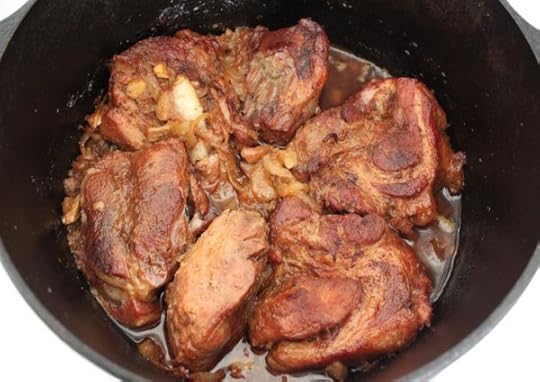 As if slow-cooked, tender, succulent pork wasn’t tempting enough, carnitas takes it one step further by caramelizing the pork in its own fat until the outside is perfectly browned and crisp. The crispy, tender morsels of pork that come out of the oven are hard to resist; it’s not unusual to eat so much meat right out of the pan that you’re full before the carnitas make it to the table.
As if slow-cooked, tender, succulent pork wasn’t tempting enough, carnitas takes it one step further by caramelizing the pork in its own fat until the outside is perfectly browned and crisp. The crispy, tender morsels of pork that come out of the oven are hard to resist; it’s not unusual to eat so much meat right out of the pan that you’re full before the carnitas make it to the table.
Cooking meat that is both tender and crispy might sound tricky but the only trick to making carnitas is getting out of the way so the meat can cook itself. The less you intervene, the better. Seasoned pork is braised in a pot of water until the meat is tender and the water is gone. Then the pork fat takes over, essentially frying the meat into a crispy, fatty, salty masterpiece.
Carnitas is a great dish to cook ahead of time for quick weeknight dinners or large parties. Served with avocado, salsa or sautéed peppers it’s a meal that satisfies every time.
Servings: 6
Time in the Kitchen: 20 minutes active cooking time, 3 to 4 hours in the oven
Ingredients:
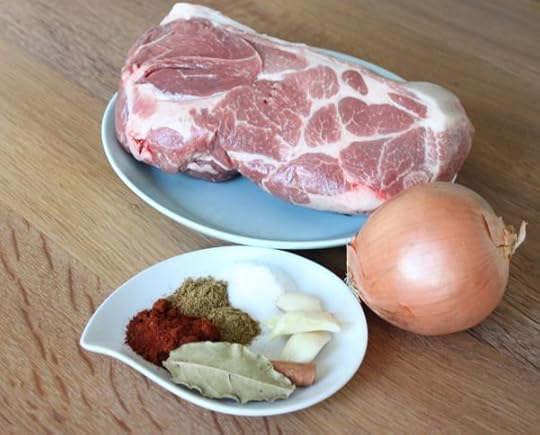
3 to 4 pounds boneless pork shoulder/butt cut into five pieces. You can trim off a little bit of the fat or leave it all on. (1.4 to 1.8 kg)
1 1/2 teaspoons salt (7 ml)
1 teaspoon cumin (5 ml)
1 teaspoon chili powder (5 ml)
1 cinnamon stick
1 bay leaf
4 garlic cloves, thinly sliced
1 onion, chopped or thinly sliced
Water, for braising
Instructions:
Preheat the oven to 350 ºF (177 ºC).
Mix together the salt, cumin and chili powder and rub all over the meat.
Place the meat in a large, heavy pot with the cinnamon stick, bay leaf, garlic and onion. Ideally, the pot is large enough so that the meat is in a single layer. Add enough water to almost, but not entirely, cover the meat.
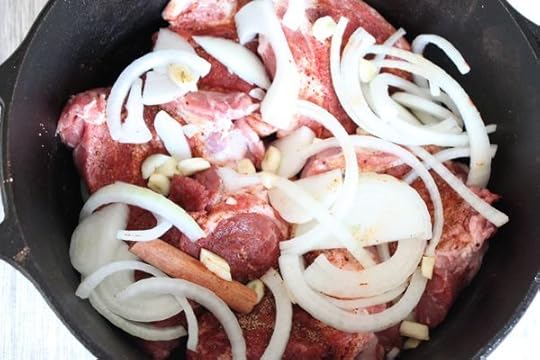
Put the pot in the oven, uncovered, and braise for 3 to 3 1/2 hours. Stir the meat just a few times while it cooks. You’ll know the pork is done when it’s really tender, slightly browned and most of the liquid is gone.

Remove the pork from the oven. Put the meat on a cutting board and cut or shred it with your hands into thin strips.
Remove the cinnamon stick and bay leaf from the pot. Add the shredded meat back to the pot and return it to the oven.
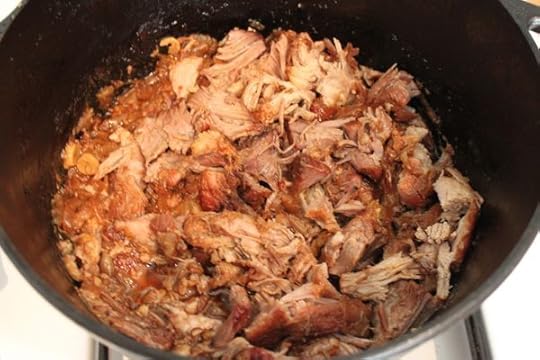
Roast the meat, mixing occasionally, until the meat is as dark and crispy as you like it. (This process will go even faster if the meat is spread out on a roasting pan or baking sheet with any remaining liquid that was left in the pot. If time is tight, you can also put the meat under a broiler).
If you’re making carnitas ahead of time, cook the meat for 3 hours until tender. The final crisping up in the oven can be done right before serving the meat.
The entire cooking process for carnitas can also be done on a stovetop but the oven is a little easier. A slow cooker can also be used to cook the meat until tender (add only about 1/2 cup of water). The meat can then be transferred to the oven to brown.
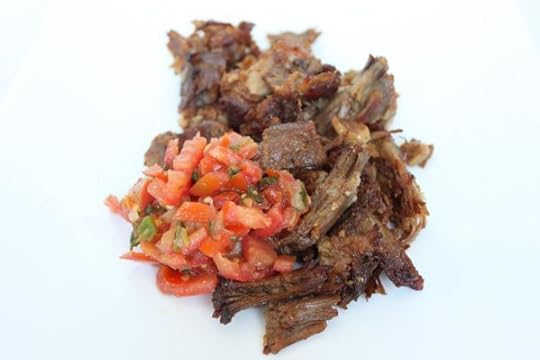
Get All Three Primal Cookbooks, an Apron and More in The Primal Blueprint Chef Kit Today!

January 4, 2013
Flab to Fab in 7 Easy Months
It’s Friday, everyone! And that means another Primal Blueprint Real Life Story from a Mark’s Daily Apple reader. If you have your own success story and would like to share it with me and the Mark’s Daily Apple community please contact me here. I’ll continue to publish these each Friday as long as they keep coming in. Thank you for reading!
P.S. This story was titled by the author of the story, Erin.
 Dear Mark,
Dear Mark,
I am so excited to have a story I feel is worth submitting to the Primal Blueprint Real Life Stories. It’s certainly not anything I imagined at the beginning of this journey.
My story began like so many of the other stories I’ve read on Mark’s Daily Apple. Although I was very skinny in my younger years, sometime around puberty I started to pick up “baby fat” even though I’d had none previously. Through college my weight would fluctuate up and down. One year I’d be a size 6, and the next a 10. My eating habits, like most college students, were awful, but I walked almost everywhere I went, and my job working with children kept me on my feet all day, so I always stayed in an “average” range.
In my early 20s, when I stopped living within a mile radius of everywhere important I had to be and started working a job that involved a lot more sitting, I noticed the weight start to creep on again. However, this time it stayed. I wasn’t happy with this new development, and started to make some changes.
Thus began the vicious cycle of Chronic Cardio and CW diet that would inevitably lead to disappointment and giving up, only to try again 6 months later when my pants didn’t fit. I can remember at one point going to two back to back fitness classes three times a week (one strength and one cardio), and spending 60 grueling minutes on the treadmill or elliptical the other four days. I would go home and eat some low fat, whole grain dinner and count my calories like my life depended on it. However, despite all of this work, I could only take off 5-10 lbs and wasn’t seeing the kind of results that would make my effort feel worth it.
In my mid-20s my doctor did some routine blood work and told me I was hypoglycemic. She recommended I check out an insulin resistance diet and make some changes, since the cycle of hypoglycemia can often lead to diabetes. I started to eat more protein and less carbs (I still held tight to the whole grains, I was a self-proclaimed pasta addict), and did actually lose some weight. But life happened and I quickly fell off the wagon.
Somewhere along the line, I resigned myself to “the way things were” and decided I clearly wasn’t blessed with the genes to obtain the body I wanted. Unfortunately, that resignation, combined with taking on an incredibly stressful and demanding job in the summer of 2011, led to a hefty weight gain.
In the spring of 2012 I attended a dog show (I show Australian Shepherds) and was so excited to have a wonderful weekend full of many wins. Winning dogs means taking win pictures. When I pulled up the website to order my win pictures, though, I was horrified at the me that I saw. I mean, yes I had had to buy a new outfit the week before because my usual skirt and jacket suits didn’t fit anymore, but I wasn’t prepared for the image I saw. It was truly a low point for me to have a visual that, at only 26 years old, I was heavy and out of shape.

I knew it was time for a radical change, but didn’t know what that was since nothing had ever given me “big” results before. Around that same time, one of my Facebook friends shared an article from Mark’s Daily Apple titled “17 Reasons You’re Not Losing Weight.” I was hooked.
I spent the next week reading through everything on MDA and immediately went out and bought The Primal Blueprint 21-Day Total Body Transformation. I was hesitant to get my hopes up, since I’d only been disappointed in the past, but was shocked to lose 7 lbs in the first two weeks! The poor people around me got really tired of hearing about “Primal” and “Mark says…,” but they were certainly noticing my results.
After a few weeks on the PB diet I noticed I had more energy, slept better, and was just generally a happier person. I walked, a lot, and even got my company to put in a standing desk for me at work. The weight just kept melting off without any kind of effort on my part. For the first time in years I stopped getting that awful low blood sugar feeling if I didn’t eat something every few hours. And the best part is I was never hungry.
A couple months in I added some IF into the mix. I never really planned a fast, but I would wake up and just wouldn’t eat until I was hungry. The fat really started to come off then, and my body was starting to really shape up.
I’ve gotten into boot camp recently, and do it 2-3 times a week for my strength training and play (I genuinely love it). The most amazing thing, to me, is that I can “exercise” just a couple of times a week and get much bigger results than when I used to spend hours in the gym. When your body is doing what it was meant to do, it’s actually not difficult at all!
All in all, I went from a size 12 or 14 (I’m honestly not sure as I stopped keeping track at some point and wore a lot of clothes with “give”) down to a size 4 in about 7 months. I never thought I’d see a 4 again! I’ve lost over 40 pounds, and the fat is still coming off as I continue to work on toning my body up and building some muscle.
I can now go for a run “just for fun” and not be out of breath in a quarter mile. I can have a camera turned on me and not feel instant anxiety. I can skip a meal and not be tired and grumpy because my blood sugar is low. And most of all, I feel great and I look great.
Oh, and those dog show suits… they still don’t fit, but now it’s because they fall off of me.
Erin
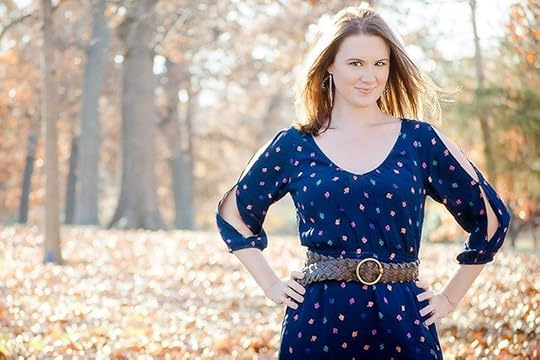
Grab a Copy of The Primal Blueprint 21-Day Total Body Transformation and Start Getting Primal Today!

January 3, 2013
A Different Kind of Fitness Resolution
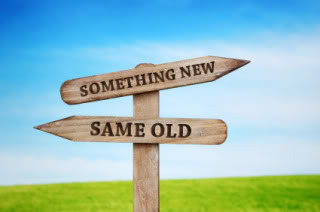 It’s the month when gym memberships spike and fitness equipment flies off store shelves. I think most of us begin the year wanting to be healthier, and fitness stands as an essential element of that endeavor. Logical. Reasonable. Commendable. Yet, the common interpretation of what it will take to get there suddenly veers off in a white knuckle, nonsensical detour. Yes, let’s hear it for the chronic cardio model. As a former cardio king, I rack my brain questioning why so many people still subscribe to the “exhaustion or bust” mentality. (It’s unfortunately one of the reasons many said memberships will go unused by the middle of next month and the aforementioned equipment will begin gathering dust in a corner.) As with so many aspects of healthy living, the conventional fitness culture often misleads because it ignores what can and should be its ultimate guide – the nuanced role of physical activity in evolution and the simple but rather elegant connections that movement has to overall vitality.
It’s the month when gym memberships spike and fitness equipment flies off store shelves. I think most of us begin the year wanting to be healthier, and fitness stands as an essential element of that endeavor. Logical. Reasonable. Commendable. Yet, the common interpretation of what it will take to get there suddenly veers off in a white knuckle, nonsensical detour. Yes, let’s hear it for the chronic cardio model. As a former cardio king, I rack my brain questioning why so many people still subscribe to the “exhaustion or bust” mentality. (It’s unfortunately one of the reasons many said memberships will go unused by the middle of next month and the aforementioned equipment will begin gathering dust in a corner.) As with so many aspects of healthy living, the conventional fitness culture often misleads because it ignores what can and should be its ultimate guide – the nuanced role of physical activity in evolution and the simple but rather elegant connections that movement has to overall vitality.
Sure, this could be a book unto itself (or several). What got me thinking was a New York Times article called “Exercise and the Ever Smarter Human Brain.” It highlights research that connects higher endurance capacity in species to larger brain-to-body size proportions as well as the effect of “endurance exercise” on BDNF (brain-derived neurotrophic factor), a protein associated with brain growth and neuroplasticity. According to anthropologist David A. Raichlen, the extra BDNF that our human forebears developed in their endurance pursuits (e.g. chasing prey) was able to “migrate” to the brain’s use. Over time and selection, the added BNDF became a boon to early human cognition. Incidentally, research today suggests the same principle. When we exercise, we benefit from a temporary boost in BDNF and an apparent upregulation in cellular processing of BDNF. With more BDNF in circulation, researchers speculate that more is available to be assimilated into central tissue and offer beneficial neurological impact.
I love this. (But there’s one thing that sticks in my craw.) Let me explain. I love it because it highlights an absolutely essential principle that still doesn’t get enough press: movement is critical for cognitive health and neuroplasticity – the forces that keep us sharp and creative over the course of our lifetime. It also connects evolution with our current physiological needs. (Gotta love the Grok factor.) Our bodies and brains need exercise today because we are products of an evolutionary design that intertwined them both.
As for the frustrating bit, I question how many people will look at “endurance” and think the only way to access this benefit is to slog away on the treadmill or spin (class) themselves into delirium. As I’ve said many a time, our ancestors’ version of endurance didn’t involve marathon training. Chasing prey – even to the point of exhaustion (as the researchers who were noted in said article postulate) – wasn’t an exercise in constant motion. Mental tenacity and strategy would’ve mattered as much if not more than actual physical endurance. This kind of persistence hunting wouldn’t have been an everyday occurrence anyway. Grok’s endurance was built around a mix of extended walking and low level activity interspersed with bouts of power, strength, and sprinting.
It’s the nature of our evolutionary activity that tells us the most when we’re looking to expand our own physical abilities. Our ancestors’ fitness developed through frequent but fractal activity. Their movement was variable throughout the days and weeks. It often took precision but also let loose in creative play. It was rarely rushed. Although it might have been routine at times, it wasn’t careless.
Sometimes in our motivation to get to the next level fitness-wise (whether we’re beginners or performance athletes), we simply push ourselves harder at the same game, the same activities, the same game. It’s not what our evolutionary story suggests is the answer, and it’s not what modern research tells us is the most effective path.
In an interesting new field of research called neuromovement, for example, experts like Anat Baniel emphasize the potential of movement to build new neurological pathways that in turn support expanding physical abilities and healthier neurological functioning. It’s reciprocal benefit at its best that taps into – as well as extends – the powers of neuroplasticity. (The body and brain after all are still as imbricated as they were in their evolutionary development.) The approach has revolutionary potential for those with chronic pain or movement based disorders and disabilities, but the philosophy behind neuromovement can benefit people without impairments and even professional athletes. The fact is, we all have rigidity of some kind to move past – whether it’s a wall we hit in our performance or a limited focus in what we do for movement and exercise in a day.
Baniel highlights nine “essentials” that offer food for thought in rethinking movement in our lives. Within these, she stresses the importance of elements like attention, subtlety, awareness, slowness, and variation. (I think there’s something decidedly Primal at work here.) It’s worth asking, how these principles can help us break boundaries in our own fitness and movement each day.
Whether it’s the ancestral model of the PB or the nuances of the latest neuromovement research, what a contrast there is to how we often approach movement today. We look for every technological contraption and short cut to avoid 90% of activity a day but then spend an hour making up for our sedentary life on the same machine doing the same mindless motion? The struggle that characterized our evolution was anything but sedentary. Likewise, the terrain that refined our development wasn’t anything akin to an elliptical machine. Although we’re burning calories, strengthening some muscles, and offering our cardiovascular system a sporadic (but not ideal) bout of exertion, we’re missing out on the full, subtle, and fractal spectrum of physical benefits – not to mention the plain fun.
Thanks for reading today, everyone. Do your resolutions include something in the fitness realm? Good luck with your new year challenges, and offer your thoughts in the comment board. Have a great weekend.
The Sequel to The Primal Blueprint Releases on January 8
 Next week (next week!) I’ll be releasing The Primal Connection, the long-awaited sequel to The Primal Blueprint. As friends and colleagues within the ancestral movement have so generously described, The Primal Connection offers the first really new dimension in the paleo/Primal space in years. Is there any better way to start the new year – not to mention the fact that we all survived the Mayan apocalypse? In all seriousness, I’ve been pumped about this launch for months now.
Next week (next week!) I’ll be releasing The Primal Connection, the long-awaited sequel to The Primal Blueprint. As friends and colleagues within the ancestral movement have so generously described, The Primal Connection offers the first really new dimension in the paleo/Primal space in years. Is there any better way to start the new year – not to mention the fact that we all survived the Mayan apocalypse? In all seriousness, I’ve been pumped about this launch for months now.
Like The Primal Blueprint, The Primal Connection is both a culmination and expansion of principles I’ve first introduced here on MDA. It picks up where The Primal Blueprint left off, by extending the primal theme beyond the diet and exercise basics. In it I present a comprehensive plan to overcome the flawed mentality and hectic pace of high-tech, modern life and reprogram your genes to become joyful, care-free, and at peace with the present. Inherent to The Primal Connection is the concept that we can use the model of our ancestors to create not just a healthier existence but also a more balanced and fulfilling life. My hope is that upon reading it you’ll emerge with a renewed appreciation for the simple pleasures of life and our most precious gifts of time, health, and love.
Just as I did for Primal Blueprint Healthy Sauces, Dressings & Toppings earlier this month, I’ll have something special put together for devoted Mark’s Daily Apple readers when this book is released on January 8th, 2013. So mark your calendar and be ready to jump on the offer while it lasts.
P.S. If you’ve pre-ordered a copy of The Primal Connection, don’t worry. All pre-orders will be eligible to receive the free bonuses that will be part of the book release offer.
Don’t Miss It! Receive an Email Alert When the Limited-Time Offer is Announced by Subscribing to the Mark’s Daily Apple Newsletter

January 2, 2013
Are You Eating These Important Supplemental Foods?
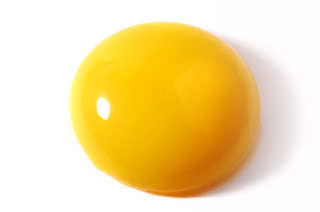 Today I’d like to talk about supplementation. No, not vitamins. While I obviously believe supplements of the pill, tablet and powder form variety can play a role in a healthy, modern Primal lifestyle, that’s not what I have in mind today. Instead, I’d like to take a look at supplemental foods – multivitamins provided in whole food form by mother nature (often aided and abetted by cooks, cheesemakers, farmers, ranchers, shepherds, and the like). In my estimation, there are a few absolutely essential supplemental foods that we should be eating.
Today I’d like to talk about supplementation. No, not vitamins. While I obviously believe supplements of the pill, tablet and powder form variety can play a role in a healthy, modern Primal lifestyle, that’s not what I have in mind today. Instead, I’d like to take a look at supplemental foods – multivitamins provided in whole food form by mother nature (often aided and abetted by cooks, cheesemakers, farmers, ranchers, shepherds, and the like). In my estimation, there are a few absolutely essential supplemental foods that we should be eating.
Most of you are probably eating a few of these foods regularly, and some may be eating most of them, but I’d wager that none of you are eating all of them on a regular basis. Check the list, see what you’re missing, and adjust accordingly.
Egg yolks
Egg yolks are number one in my book. The way they blend effortlessly with other foods and even enrich them, and (if you get a really pastured one) provide unparalleled taste and mouthfeel when eaten straight out of the shell can’t be praised enough. The vitamin A, choline, folate, selenium, iodine, and omega-3 (again, if you get pastured) are rather nice, too. Eat egg yolks every day, just don’t smoke ‘em. Yes, that was a double reference to both the egg yolk/cigarette study and Dr. Dre.
Liver
Since every animal comes with but a single liver, it’s tough to get more than a few ounces if you’re sharing with everyone else in the group. Good thing liver is the most nutrient-dense food on the planet, so nutrient-dense that eating more than a half pound to a pound a week is probably overkill and will net you an excessive amount of certain nutrients.
Seaweed
Seaweed is green vegetation that’s been marinating in mineral-dense seawater for its entire life, and when you eat seaweed, you get the best source of iodine, plus magnesium, manganese, iron, and tons of other trace minerals that you might be (probably are) missing out on. Some of the healthiest traditional cultures consider seaweed a staple food, and essentially every group of coastal people utilized sea vegetables in their diets. Sprinkle kelp or dulse flakes on food, make broth using dried kombu, eat seaweed salad when you go out to eat sushi, roll up avocado and meat in nori wraps – the possibilites are many and delicious.
Turmeric
You might have read my old post on turmeric, thought, “Huh, interesting,” gone out for Indian that night, and never thought about it again. That’s a mistake, in my opinion, because turmeric is delicious and a true health food. It and its primary bioactive component – curcumin – have been shown to be anti-inflammatory, anti-lipid peroxidative, blood lipid-improving, and anti-carcinogenic in human studies. Contrary to popular belief, turmeric doesn’t just go with Indian food. I often sprinkle it liberally on my eggs, meat, and vegetables, and I even make a tea out of it. So no, you have no excuse not to use more turmeric more often. Add black pepper to increase the benefits.
Bone broth
It can feel like a chore to make, but it’s really not. Get bones, cover with water, heat, strain. It only seems like a big job. Once you get going, though, it’s easy enough. Make it a routine, to make it even easier and ensure that you have bone broth on hand at all times. Just be sure to clean those pots right away; dried, obliterated skeletal matrices are tough to scrub off of stainless steel pots. As for the benefits, bone broth is a good source of minerals and gelatin. If you’ve been pounding the muscle meat, balancing the amino acid methionine out with some glycine from gelatin is advised, since methionine metabolism depletes glycine. Gelatin also improves joint pain and sleep quality. I hate the former and love the latter, so I make and drink bone broth.
Bone marrow
Bone marrow is an interesting one. It’s plainly obvious why humans and their ancestors have been seeking it out for millions of years – it’s fatty, calorie-dense, and delicious – but its nutritional value beyond macronutrients is a bit more murky. In a previous post on bone marrow, I tried to divine the specifics and came to the shaky conclusion that since marrow is actively involved in bone and connective formation and resorption, we can effectively think of it as an organ and thus assume it to be nutrient-dense. I think that still holds. No, there are no studies or nutritional databases to confirm this, but I’m going to go out on a limb and propose we consider bone marrow to be an important supplemental food.
Shellfish
Over a year ago, I told you guys to start eating shellfish. Did you? Well, consider this another notification that shellfish, particularly oysters and mussels, should be a regular part of your diet. Why oysters? Just four medium sized Pacific oysters supply a smattering of B-vitamins (including over 1000% of daily B12), 1200 IU of vitamin A, a third of daily folate, almost 7 mg of vitamin E, 3 mg copper, 280% of daily selenium, and 33 mg zinc. That comes with 18 g protein, 4 g fat, 1.5 g omega-3, 0.1 g omega-6, and 9 grams of carbohydrates. Why mussels? They’re also rich in B-vitamins, selenium, zinc, and protein, but also come with good amounts of magnesium and manganese. Other shellfish are also good, but probably not as important as oysters and mussels.
Aged cheese
Gouda and pecorino romano are ideal choices. Gouda is the cheese with the highest vitamin K2 content, and the longer the cheese is aged (fermented), the more K2 it picks up. Pecorino romano, by definition, must come from raw sheep’s milk grazed on lush grasses, and it must be made the traditional way – from animal rennet. The result is a salty, sharp cheese with bite, CLA, and the ability to “cause favourable biochemical changes of atherosclerotic markers.”
Natto
I know, I know. It’s soy, a legume with significant levels of phytoestrogens, phytic acid, and trypsin inhibitors. It’s got a gross, slimy texture that may be outdone only by its interesting taste. It’s soy. By most accounts, people following a Primal lifestyle shouldn’t have anything to do with it. If you asked me a couple years ago, I may have said that. But natto is a special kind of soy. It’s fermented using a particular strain of bacterium called Bacillus subtilis natto. When steamed soybeans are inoculated with b. subtilis, they are transformed from a basic legume with few redeeming qualities into a powerful supplemental food imbued with high levels of vitamin K2, a nutrient important in bone mineralization, cancer prevention, and protection from heart disease. If you’re into those sorts of things, natto is the single best source of vitamin K2.
Tiny whole fish with heads and guts
Anytime you can eat the entire animal, you should. Heck, if they were able to genetically engineer bite-sized cows, I’d be all over that (assuming they were grass-fed, of course). Until then, tiny fish with heads and guts will do the trick. I’m talking sardines. I’m talking anchovies. I’m talking smelt. I’m talking any of the fish running between a half inch and six inches long. Any longer and the guts will begin to stand out in your mouth. But if you keep to that sweet spot, you’ll get the brains, the glands (all of them), the organs, the bones, the fermenting algae, krill, and assorted sundry microscopic marine goodies tiny fish like to eat, in addition to the omega-3s and protein, without adverse flavors. Oh, and because they’re tiny and low on the food chain, tiny fish will be largely free of the heavy metals other, larger fish tend to accumulate.
Red palm oil
For the PBer who fears almonds and other nuts and seeds for the omega-6 content, vitamin E is scarce in the diet. Some would argue that vitamin E is only there to prevent oxidation of omega-6 present in foods, and there’s something to that. But still: dietary, full-spectrum vitamin E is a powerful antioxidant, and red palm oil is the richest source of the full-spectrum variety. It’s also a good source of CoQ10, another powerful nutrient. Oh, and it tastes good (once you get used to the unique flavor). Go for African palm oil instead of Southeast Asian, because the former isn’t produced on the backs of dead orangutans.
Brazil nuts
Selenium, selenium, selenium. This essential little mineral is woefully absent from most people’s diets, and it’s a shame: selenium is vital for thyroid hormone production, the manufacture of endogenous antioxidants, and sex hormone production. Brazil nuts are the best source of selenium. Many of the previously listed foods are going to get you plenty of selenium, but brazil nuts are nice to keep around for those days when you haven’t been eating your lamb kidneys, mussels, and anchovies. Just pop two or three brazil nuts and you’ll have more than a day’s worth heading straight to your gastrointestinal tract. Easy peasy. Go for the ones in their shells if you can, since those are going to be fresher than the shelled nuts.
Speaking of brazil nuts, I’ve always wondered whether to capitalize the “b” or not. Any thoughts?
Purple/blue foods (sweet potatoes, berries, vegetables)
As I’ve said before, bright colors in plants often indicate the presence of potent polyphenols – bioactive compounds found in plants. No bioactive color has been more studied and lauded than the blue/purple anthocyanins, which are linked to anti-inflammatory, anti-atherosclerotic, and anti-carcinogenic effects and can pretty much be found in any blue or purple fruit, vegetable, or tuber. So, Okinawan sweet potatoes are great sources. Blueberries, raspberries, currants, purple grapes, and blackberries are great. Red lettuce, radicchio, and purple cabbage, cauliflower, kale, tomatoes, and carrots are also rich with anthocyanins. If it’s purple or blue and edible, it’s probably worth eating.
Fermented food
Since modern medicine is steadily unearthing new connections between the gut microbiome and a host of health and disease states, we know we should pay attention to our gut flora. I can’t tell you to go eat dirt and stamp around barefooted in parasite-ridden water (even though both may theoretically have their benefits), but I can tell you to eat a mix of fermented foods. You’ve got your yogurts, your kefirs, your sauerkrauts, your kimchis, your (aforementioned) nattos, your beet kvasses, your kombuchas. Benefits include more numerous and more bioavailable nutrients, new nutrients, new genetic material for your gut flora to acquire, and membership into a tens of thousands of years-old fermented food appreciation Meetup group with billions of members from every culture that came before us. In other words, gut flora is important, everyone who’s anyone regularly ate fermented food, and you should too.
So, how’d you do? Does this look familiar to you? Are you eating these foods, or are you missing out? Let me know in the comment section, and be sure to mention any foods I might have missed. Thanks and have a great day!
Grab a copy of Primal Blueprint Quick & Easy Meals for over 100 Primal Recipes You Can Prepare in 30 Minutes or Less

January 1, 2013
New Year, New You: Making 2013 Your Best Year Yet
 Way back in 2006, Mark’s Daily Apple quietly went live in an unknown corner of the Interwebs. Months went by; months of what seemed like me just talking to myself. In due time, people started dropping by to enjoy and comment, and soon the discussion became lively. Buoyed by community support, I wrote and wrote. Every day I wrote, slogging toward the ambitious goal of helping 10 million people cast aside flawed conventional wisdom and take control of their health and wellbeing.
Way back in 2006, Mark’s Daily Apple quietly went live in an unknown corner of the Interwebs. Months went by; months of what seemed like me just talking to myself. In due time, people started dropping by to enjoy and comment, and soon the discussion became lively. Buoyed by community support, I wrote and wrote. Every day I wrote, slogging toward the ambitious goal of helping 10 million people cast aside flawed conventional wisdom and take control of their health and wellbeing.
Since launch day in 2006, so much has changed. At the time, “Primal” or “paleo” had few followers and fewer evangelists. Now, everyone and their granny has a paleo blog or podcast, and the ancestral movement has made significant inroads in the shaping of mainstream media and popular thinking about health and wellness. And I couldn’t be more delighted.
Of course, much has changed at Mark’s Daily Apple since then as well. Out of all my writing came The Primal Blueprint; a 2009 book, and a set of guiding principles that changed everything for me. Then came the cookbooks, PrimalCon, Primal seminars, and so much more. Not to mention the thousands of success stories that bore witness to the power of living like Grok.
The momentum of the movement is undeniably strong. As one of my physician friends commented to me recently, it’s going to take a couple decades for mainstream science and medicine to recalibrate their flawed, entrenched positions; for individuals, it’s simply a matter of whether one wants to wait around and suffer the consequences, or become informed and stay ahead of the curve. That’s what Mark’s Daily Apple is all about really – being open-minded, setting the pace to stay ahead of the curve, and hopefully generating a critical mass so it becomes easier and smoother to buck conventional wisdom.
For 2013, my team and I want to offer as much support as possible to help you, and your family and friends, achieve your health and fitness goals. We believe that as long as you have the right tools, guidance, and inspiration you can achieve just about anything. So here’s a brief summary of what we have lined up for this year. Not everything is listed. Mark’s Daily Apple will be seeing some improvements in 2013 that aren’t discussed below, for example. There are a few surprises that you’ll have to check back for, but this captures how we plan on providing you with what you’ve been requesting. Let me know what you think in the comment boards. Grok on!
The Primal Connection
 On January 8, I’ll be releasing The Primal Connection, the long-awaited sequel to The Primal Blueprint. As friends and colleagues within the ancestral movement have so generously described, The Primal Connection offers the first really new dimension in the paleo/Primal space in years.
On January 8, I’ll be releasing The Primal Connection, the long-awaited sequel to The Primal Blueprint. As friends and colleagues within the ancestral movement have so generously described, The Primal Connection offers the first really new dimension in the paleo/Primal space in years.
Like The Primal Blueprint, The Primal Connection is both a culmination and expansion of principles I’ve first introduced here on MDA. It picks up where The Primal Blueprint left off, by extending the primal theme beyond the diet and exercise basics. In it I present a comprehensive plan to overcome the flawed mentality and hectic pace of high-tech, modern life and reprogram your genes to become joyful, care-free, and at peace with the present. Inherent to The Primal Connection is the concept that we can use the model of our ancestors to create not just a healthier existence but also a more balanced and fulfilling life. My hope is that upon reading it you’ll emerge with a renewed appreciation for the simple pleasures of life and our most precious gifts of time, health, and love.
Just as I did for Primal Blueprint Healthy Sauces, Dressings & Toppings last month, I’ll have something special put together for devoted Mark’s Daily Apple readers when this book is released. So mark your calendar and be ready to jump on the offer while it lasts.
Primal Blueprint Publishing
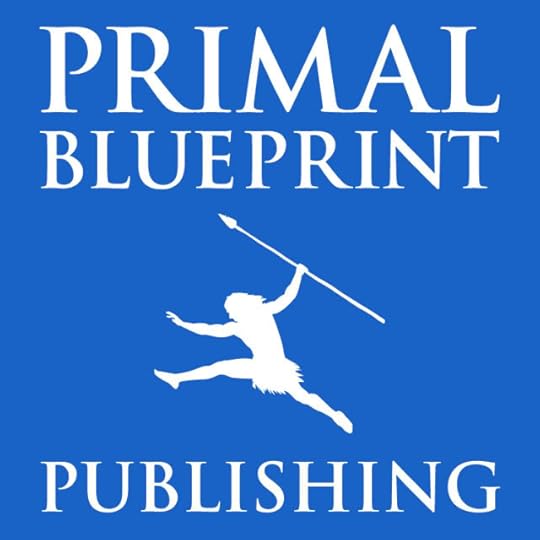
They say every cloud has a silver lining, and that’s certainly true with the publication of The Primal Blueprint in 2009. When no mainstream publisher or agent wanted to take a chance on some unknown blogger touting a decidedly fringe movement, I was compelled to take matters into my own hands and self-publish. Well, we learned the ropes quickly and realized that indeed it was possible to make inroads into the publishing community without having a high rise office in New York City. With a good handful of titles in our catalog, and strong relationships established throughout our manufacturing and supply chain, we are becoming full-fledged publishers here in Malibu, CA. That’s right, in 2013 you will see an assortment of works from other authors released under the imprint of Primal Blueprint Publishing. The authors we publish are aligned with the philosophy of the Evolutionary Health Movement, but bring all kinds of fresh perspectives and specialized areas of expertise to the table. First up in our publishing lineup is Jayson and Mira Calton’s Rich Food, Poor Food. This dynamic couple, both experts in nutrition, have navigated every single aisle of the grocery store to help you choose the most nutrient-rich foods for you and your family, and steer clear of the hype and misinformation that are commonly found on labels and advertisements.
A website and blog will be going live at PrimalBlueprintPublishing.com next week to feature all PBP titles, authors, and the latest happenings in the Primal publishing biz, so stay tuned for that, too.
Primal Fuel 15-Serving Option
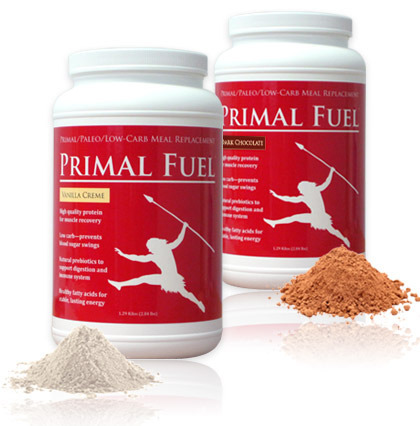 As I wrote a couple weeks ago, back when I first released Primal Fuel I pledged to lower the price of it when and where I could (without cutting any corners on quality) through volume sales and larger ingredient buys. And so I did on December 19, reducing the price of Primal Fuel (30 servings/canister) by a further $10.
As I wrote a couple weeks ago, back when I first released Primal Fuel I pledged to lower the price of it when and where I could (without cutting any corners on quality) through volume sales and larger ingredient buys. And so I did on December 19, reducing the price of Primal Fuel (30 servings/canister) by a further $10.
Now, in a continued effort to make Primal Fuel more accessible, convenient and affordable, I’ve listened to your requests for a smaller canister option. Later this month Primal Fuel will be available in a 15-serving supply at approximately half the cost of the 30-serving canister.
One-on-One Email Support
I’ve received more requests for one-on-one support than for probably just about anything else in recent years. You see, I get hundreds of email every day from people looking for personalized help and answers to questions about their unique health issues. While I try to answer each and every email that hits my inbox, I’m just one guy. Soon everyone will be able to get the kind of guidance they need, and that I can’t provide on my own. Coming early this year, you can have your very own personal coach to engage in unlimited email communication relating to your diet, your fitness routine, and all of your other Primal Blueprint-related goals. You can enjoy this service as needed, on a month-to-month basis, for a nominal monthly fee. Your support will come from a highly trained elite team of Primal Blueprint certified coaches, and I’ll be hands-on, overseeing the entire operation and coaching strategy.
Primal Blueprint Meal Plan
“Okay, Mark. I totally get it. Meat, fish, fowl, eggs, veggies, fruits, nuts and seeds. Simple. Okay, now what should I eat?” I hear it all the time. And I get it. Because even when you know what to eat, it can still be a challenge to plan weekly meals, forage for healthy Primal fare, not waste the food you do buy , and do it all while carrying on with your busy modern life. So I’m partnering with a team of meal planning experts (the good folks over at PaleoPlan.com) to provide a Primal Blueprint-Certified Meal Plan. Jennifer Meier (co-author of The Primal Blueprint Cookbook, Primal Blueprint Quick & Easy Meals, and Primal Blueprint Health Sauces, Dressings & Toppings, and resident chef of Mark’s Daily Apple), my team and I will be providing meal plan subscribers with weekly meal plans, recipes and shopping lists to take the guesswork out of eating Primal. If you’re a Primal veteran, already have your go-to meals, and don’t have any problems planning ahead, this program might not be for you. But for anyone that’s just starting the Primal way of eating and needs to know exactly what to eat and what to buy at the market this will be an indispensable and helpful tool.
New 21-Day Transformation Program
Remember the Primal Leap Kit? Well, it’s been out of stock for a number of months as we’ve been retooling the package. The new kit will be called the 21-Day Transformation Program. It will be available later this month with a comprehensive package of multi-media material and online support features. It will include a DVD of a Primal Blueprint Transformation Seminar I gave in Chicago last year, and much more. If you or anyone you know has struggled to transition to Primal eating, struggled to lose fat or keep it off, or requires intensive support to kick-start a 21-day lifestyle transformation, this program is the ticket. It’s simply everything you need to go Primal and do it the right way in a single package.
The Primal Blueprint Certification
We are hard at work creating what amounts to a series of upper division University-level courses on the Primal Blueprint. We will offer this certification program online, catering not only to personal trainers and health professionals, but anyone who wishes to deepen his or her knowledge about the Primal Blueprint, and hone the skills necessary to guide others to eat, exercise and live Primally. The certification program consists of 13 “modules” that align with the eight Key Concepts and five Action Items of The Primal Blueprint 21-Day Total Body Transformation. Each module contains written content, a video presentation of me overviewing the content, and a written examination. The coursework will be rigorous, and when you emerge successfully, you will be designated as a Primal Blueprint certified expert.
PrimalCon
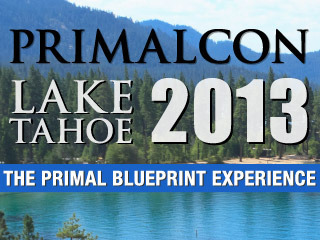 With the announcement and prompt sellout of both 2013 PrimalCon events, Oxnard (April 11-14) and Lake Tahoe (Sept 26-29), we know that PrimalCon is here to stay. We hear the voices clamoring for PrimalCon at other locations and are considering plans for alternate venues. With my schedule the way it is, it’s clear that PrimalCon will outgrow my ability to attend each one. However, the team of presenters that are on board is simply awesome, and certainly can support additional gatherings for the magic connection that is PrimalCon.
With the announcement and prompt sellout of both 2013 PrimalCon events, Oxnard (April 11-14) and Lake Tahoe (Sept 26-29), we know that PrimalCon is here to stay. We hear the voices clamoring for PrimalCon at other locations and are considering plans for alternate venues. With my schedule the way it is, it’s clear that PrimalCon will outgrow my ability to attend each one. However, the team of presenters that are on board is simply awesome, and certainly can support additional gatherings for the magic connection that is PrimalCon.
Primal Blueprint Transformation Seminar
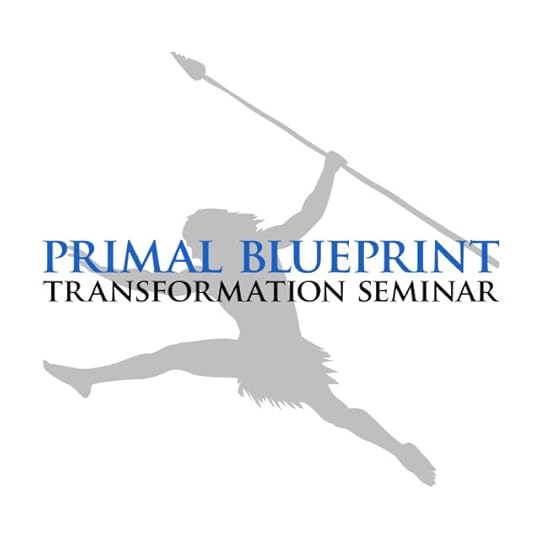
After our successful nationwide tour of 23 cities in 2012 led by Brad Kearns, we now have Tara Grant stepping up to deliver some soon-to-be-scheduled seminars in 2013. It’s hard to imagine a better presenter than Tara, a living, breathing, dramatic Primal success story who turned her life around and is now a major voice promoting the Primal lifestyle to others. Her casual sessions at PrimalCon Oxnard were a huge hit last year, and she has extensive writing and public speaking experience.
Quick aside: We are about to publish, in digital form, Tara’s compelling personal story and guidebook to overcoming the health condition of Hidradenitis Supprativa. Titled, The Hidden Plague: A field guide for surviving and overcoming Hidradenitis Supprativa, it’s a must have for anyone suffering from this condition, one that is poorly understood by the mainstream medical community.
Tara will get out of the gates on January 27 in Phoenix, AZ, with a special event featuring the Primal Transformation Seminar and a Primal Cooking Class. Brad Kearns will join her to present the seminar portion, and Chef Rachel Albert, another PrimalCon Favorite, will preside over the cooking presentation. This event takes place in a private home and ticket sales are limited. If you are in or near Phoenix, don’t miss this event!
Primal Blueprint Luxury Retreat
 The dynamic duo of Vanessa and Adam Lambert are your hosts for this one-of-a-kind luxury experience at a beautiful villa in Malibu, CA. The event, slated for Jan 31-Feb 3, is limited to only 12 guests, so act quickly if you can make it to Malibu! You’ll be immersed in real world scenarios, guided step-by-step through Primal eating, exercise, and lifestyle strategies, and you will leave the weekend with a complete arsenal of knowledge to immediately and seamlessly integrate the Primal philosophy into your life. Adam and Vanessa will provide intensive hands-on coaching, and you’ll enjoy gourmet meals from the best Primal chef in Los Angeles.
The dynamic duo of Vanessa and Adam Lambert are your hosts for this one-of-a-kind luxury experience at a beautiful villa in Malibu, CA. The event, slated for Jan 31-Feb 3, is limited to only 12 guests, so act quickly if you can make it to Malibu! You’ll be immersed in real world scenarios, guided step-by-step through Primal eating, exercise, and lifestyle strategies, and you will leave the weekend with a complete arsenal of knowledge to immediately and seamlessly integrate the Primal philosophy into your life. Adam and Vanessa will provide intensive hands-on coaching, and you’ll enjoy gourmet meals from the best Primal chef in Los Angeles.
Primal Blueprint Cruise
People have been bugging me to keynote a cruise, or stage a Primal cruise, for many years. It seems like a great way to connect, enjoy some expert presentations, and have a vacation experience. I’ve heard great things about Jimmy Moore’s annual Low Carb Cruise. The reason I’ve dragged my feet on this is because my vision of a cruise is all-or-nothing. If we are going to set sail on a Primal Blueprint cruise, we must take over the entire boat so that everyone you see lounging on deck or shooting skeet is a Primal enthusiast; so that nary a dinner roll is found anywhere on board the boat; so that the dining experience is one of appreciation and alignment with the ancestral model, not a decadent gorge-fest that seems to be synonymous with the industry. Then we must have a Primal experience at each port-of-call: a hike to some ruins or a mountain top, maybe a sprint workout in some sand dunes, some paddleboard lessons, or perhaps a shopping tour of the local farmers market. You know, an authentic, total immersion Primal Blueprint cruise. Now, even the junior cruise ships are large beasts, and it’s no small endeavor to reserve one with the unbreakable promise to fill it. However, I believe we as a community can fill a ship and do this thing up right. How does the Caribbean sound in February, 2014? Hey no promises, but we are working hard to make something happen and will announce when the time is right.
I’m firmly committed to making 2013 the best year of my life, and helping you do the same for yourself. I’d love to hear what you think of what I have in store for this year, and if you have any ideas or requests I’m all ears. Here’s to a great year. Grok on!

Happy New Year from the Sissons!
Stay in the Loop on Each of the Services and Events Above by Subscribing to the Mark’s Daily Apple Newsletter

Mark Sisson's Blog
- Mark Sisson's profile
- 199 followers



